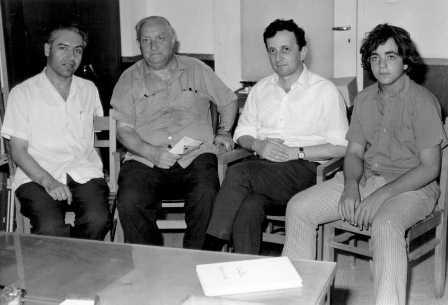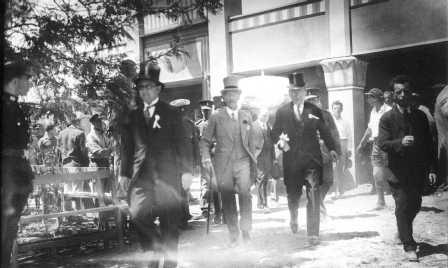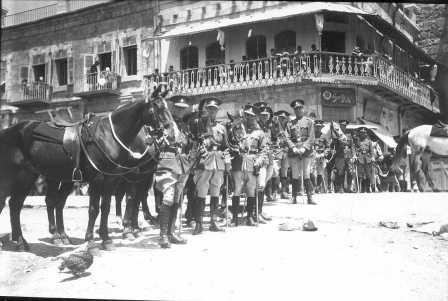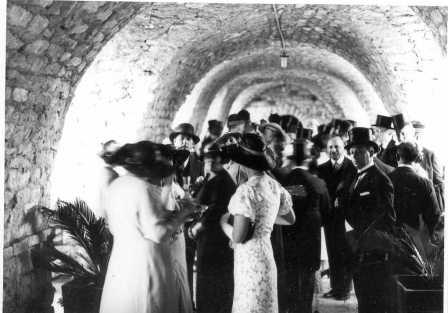 A month ago, the Eretz Israel Museum opened an exhibit of the work of Zvi Oron (Oroshkes). The photographic archive of Oron, comprising of more than 17,000 photos and 54,000 negatives, is kept at the CZA, and is an unusual documentary source of Palestine under the British mandate.
A month ago, the Eretz Israel Museum opened an exhibit of the work of Zvi Oron (Oroshkes). The photographic archive of Oron, comprising of more than 17,000 photos and 54,000 negatives, is kept at the CZA, and is an unusual documentary source of Palestine under the British mandate.
Zvi Oron was born in 1888 in Poland. He immigrated to the United States in 1913, where he started working as a photographer. He also became active in the Territorialist–Socialist movement, which aspired to establish a Jewish state, not necessarily in Israel. During WWI he joined the American battalion of the Jewish Legion. He came to Palestine as a soldier in 1919, and decided to remain there. That same year he opened a studio in Tel Aviv, and so began a long career of one of the most important photographers of pre-State Israel.
Oron worked for the Jewish National Fund for two years, but he is best remembered for the years he photographed for the Mandate Administration. In 1929 he was officially appointed by the High Commissioner, Sir John Chancellor, as the photographer of the British Mandate Government in Palestine, a title that gave him unprecedented access to British officials and military facilities. Certain elements in the Jewish Yishuv branded him a traitor and a British collaborator, but this rift with the Zionist fold, says Michal Ben Tovim, the curator of the exhibition, was to his advantage: "There are a lot of important photographers that worked in Mandatory Palestine, but most of them acted as propagandists for one camp or the other. Oron, as a Zionist photographer working for the British, was not bound by ideological strings, and could remain objective. His unbiased approach and his access to British, as well as Jewish society make his archive unique."
How to shoot a white elephant
Oron photographed Arab society as well. "His first contact with Arab society was made through the British", says Ben Tovim. "But Oron had a pluralistic outlook, and he managed to establish real connections with people outside his community, mainly within Arab urban society, that socially, had a lot in common with him. An example for that", she says, "can be seen in the fact that in 1946, the Arab High Committee, the leading body of the Palestinian national movement until 1948, invited him to photograph an official meeting where an economic boycott of the Jewish Yishuv was declared."


In his writings, Oron referred to himself as a documenter of history, "loyal to the truth alone". In retrospect, the extent of his objectivity remains an open question, the answer to which probably remains in the eyes of the beholder and the world view with which he approaches the photographs. "Oron saw himself as a journalist above all else." says Ben Tovim. "He was not a critical photographer; rather, he perceived himself as a spectator. Today, in every journalistic photograph we perceive an element of commentary, but in the 30's it was different. Journalists provided a service, not their opinion. When I look at some of Oron's photographs of Arab society, sometimes there is a sense of degradation, but I don't believe this was the photographer's intention, rather the result of historical narratives of the mandatory period that crystalized after the founding of the State of Israel. The mere act of taking a picture is an act of criticism."
A rude awakening
 The process of choosing the photographs to the exhibitions among the tens of thousands in the archive was led by two objectives- the narrative and the aesthetic ones. "The exhibition tells the story of Palestine in the 30's", Ben Tovim explains. "It's a fascinating era because it's a historical turning point. On the British side, the era begins with a sense of utopia. Wauchope, the British high commissioner that arrives in Palestine in 1932, loves the good life. He throws lavish tea parties, receptions, and sporting events. On the Jewish side, the beginning of the era is marked by an influx of bourgeois immigration that strengthens the Yishuv economically. There is a sense that although the whole world is in recession, here everything is flourishing. On the other hand, these are also the years of the Palestinian national awakening. The Arab Revolt of 1936-1939 completely changes the nature of the Mandate Government. It's the end of an era".
The process of choosing the photographs to the exhibitions among the tens of thousands in the archive was led by two objectives- the narrative and the aesthetic ones. "The exhibition tells the story of Palestine in the 30's", Ben Tovim explains. "It's a fascinating era because it's a historical turning point. On the British side, the era begins with a sense of utopia. Wauchope, the British high commissioner that arrives in Palestine in 1932, loves the good life. He throws lavish tea parties, receptions, and sporting events. On the Jewish side, the beginning of the era is marked by an influx of bourgeois immigration that strengthens the Yishuv economically. There is a sense that although the whole world is in recession, here everything is flourishing. On the other hand, these are also the years of the Palestinian national awakening. The Arab Revolt of 1936-1939 completely changes the nature of the Mandate Government. It's the end of an era".
"Aesthetically", she says, "I was looking for photographs that capture an authentic essence. I wasn't interested in the official photographs, but in the snapshots taken in between – these are the pictures that tell the story that hides behind official imagery."